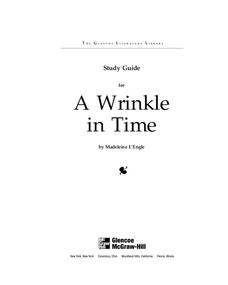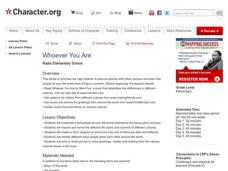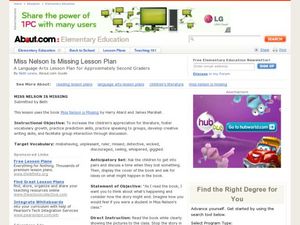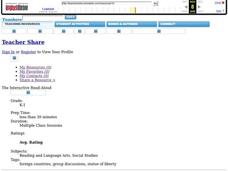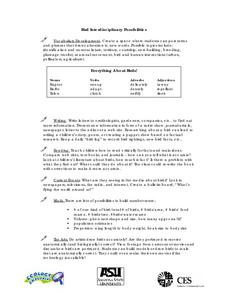Curated OER
Panda Bear, Panda Bear What Do You See?
Learners will create a self made book following the literature of "Panda Bear, Panda Bear What Do You See?" by Eric Carle. Students will color eleven characters from the story.
Curated OER
Character Traits
First graders watch a version of the story, The Tale of Peter Rabbit, and listen to the book, The Rainbow Fish, and identify the story elements of characters, character traits, setting, problem and solution.
Curated OER
Name Squares
Students examine the sounds the letters of their name make. They read Dr. Seuss' ABC Book and Mary Engelbreit's Put Em All Together. They practice writing the individual letters of their names in squares.
Curated OER
Putt-Putt Old Car
Learners study the phoneme /p/ both in written and spoken language while differentiating from the phoneme /b/. They think about the "put, put" sound that an old car makes, and work with at tongue twister. Next, they write the letter p,...
Curated OER
Travel Tags, Dr. Seuss
In this bookmarks learning exercise, learners utilize a metal ring and a hole punch to write their name on each travel tag along with the title and author of the book they read and where it took place. Students draw a picture on the back...
Curated OER
The Little Red Hen Activity Card
In this reading activity, students respond to the book The Little Red Hen by completing an activity at home with their parents. Students cut out the characters on the page and staple them to a straw. Students say the parts for each...
Curated OER
Where the Wild Things Are Activity Card
In this reading worksheet, students respond to the book Where the Wild Things Are by completing an activity at home. Students draw a picture of a terrible monster, pretend to be Max and tame the monster.
Curated OER
Trouble with Trolls
Second graders read Trouble with Trolls. In this author/illustrator lesson, 2nd graders read a story and discuss their favorite parts. Students make predictions and connections to the book.
Curated OER
Dr. Seuss Activity
In this Dr. Seuss Hop On Pop worksheet, students check either yes or no to indicate whether statements from the book are true. A website reference is given for additional resources.
Curated OER
Dr. Seuss Activity: Oh, the Birds You Can Count!
In this Dr. Seuss worksheet, students count the number of birds shown in a picture from the book Oh, The Thinks You Can Think! A website reference is given for additional resources.
Curated OER
Focus Story: The Mitten
Students explore language arts by analyzing a story with their classmates. In this poetry identification lesson, students read the book The Mittens and identify the characters, plot and settings in the story. Students recite poems about...
McGraw Hill
Study Guide for A Wrinkle in Time
Mrs. Who, Mrs. Whatsit, and Mrs. Which would not be so confused if they had a study guide as great as this. Scholars increase their comprehension of A Wrinkle In Time through many supports such as guided questions, background...
Planet e-Book
Crime and Punishment
Can an action be so bad that you are sickened with guilt? Rodion Romanovich Raskolnikov, the main character in Fyodor Dostoyevsky's Crime and Punishment, believes that committing a crime could be the answer to his troubles. However,...
McGraw Hill
Study Guide for Frankenstein
Help the class uncover the story of Frankenstein. Learners answer questions and complete activities to respond to the text Frankenstein as they read. Scholars learn new vocabulary, respond to personal and text-dependent questions,...
Curated OER
Gullah Activities
Students study the Gullah culture by watching a video about Gullah, Gullah Island. They discuss the customs and crafts of the people such as basket weaving, food preparation, pottery, and quilt making. While working in centers, they make...
Curated OER
Whoever You Are
Students examine cultures, traditions, and feeling throughout cultures. In this cultural lesson, students use literature, maps, and cultural information to examine how people have universal feelings despite their different cultures and...
Curated OER
Miss Nelson is Missing Lesson Plan
Second graders listen to the story Miss Nelson is Missing by Harry Allard and James Marshall. In this literature lesson, 2nd graders predict the story's ending with drawings and discussions within groups.
Curated OER
Over in the Meadow
Students discover how to locate books on meadow and pond animals and research them. Students discover how to locate fiction/story books about the animals mentioned in the counting book read. Students discover how to locate by author,...
Curated OER
The Island of the Skog
"Students read "The Island of the Skog." Prior to reading, students observe the book cover, predict the events of the story, and discuss what a skog may look like. Students make footprints in play dough and observe the differences...
Curated OER
The Interactive Read-Aloud
Youngsters participate in interactive read alouds about immigration.As they listen to teacher-chosen books that highlight the concept of immigration, they will be provided with opportunities to interact. They can respond to the...
Curated OER
Reading Teammates
Fourth graders read the book "Teammate" after participating in pre-reading activities that include examining the concepts of segregation and discrimination. In this six week literature study, they make timelines, discuss what they know...
Curated OER
Red Leaf, Yellow Leaf
Students discuss the differences between a storybook and an information book. Students use various materials found in nature to make a nature collage. Students make a nature dictionary using pictures and their own definitions from the...
Curated OER
Dig A Little Deeper
Here is a great lesson on recognizing events and themes in a story. Students read chapters from a chosen book and then fill out a graphic organizer to further explore the purpose of the chapter. They write the events, themes, author's...
Curated OER
Bird Interdisciplinary Possibilities
Students explore birds, their territory, breeding, and seasonal movement. They research and collect information on birds through writing letters to ornithologists, reading in books, comparing web sites, and observing pictures. Students...
